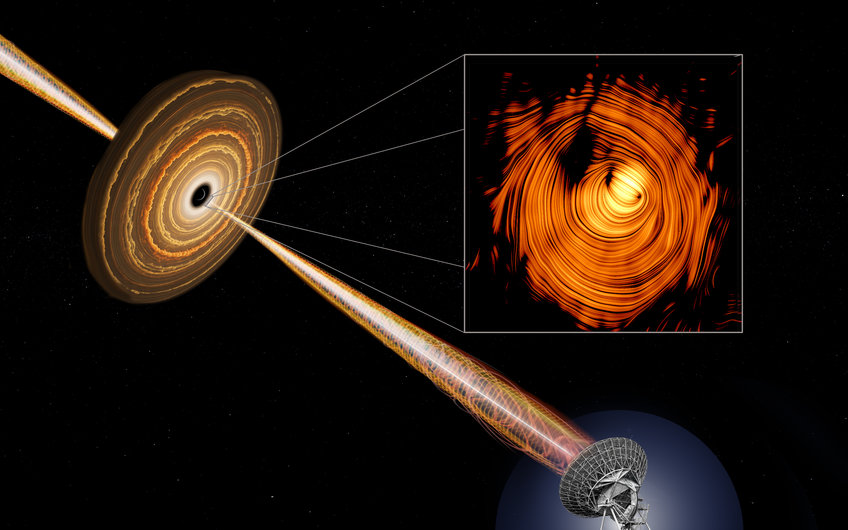
Astronomers have unveiled a remarkable image of a cosmic jet originating from an active galaxy, PKS 1424+240, revealing a ring-shaped magnetic field that may explain the galaxy’s extreme gamma radiation and neutrino emissions. The image, reminiscent of the “Eye of Sauron” from J.R.R. Tolkien’s Middle-earth, offers new insights into the enigmatic processes occurring in the universe’s most energetic environments.
Located billions of light-years away, PKS 1424+240 has long puzzled scientists as the brightest known neutrino-emitting blazar, identified by the IceCube Neutrino Observatory. Despite its intense high-energy emissions, the galaxy’s radio jet appeared to move sluggishly, contradicting expectations that only the fastest jets could produce such emissions.
Unveiling the Mystery of Neutrinos
The discovery was made possible through 15 years of precise observations using the Very Long Baseline Array (VLBA). Researchers have pieced together a highly detailed image of the jet, revealing a near-perfect toroidal magnetic field. This structure is believed to play a crucial role in accelerating particles to high energies, which in turn explains the emission of high-energy neutrinos and gamma radiation.
“When we reconstructed the image, it looked absolutely stunning,” said Yuri Kovalev, lead author of the study and Principal Investigator of the ERC-funded MuSES project at the Max Planck Institute for Radio Astronomy (MPIfR). “We have never seen anything quite like it – a near-perfect toroidal magnetic field with a jet, pointing straight at us.”
The Role of Magnetic Fields
The alignment of the jet almost directly with Earth amplifies its high-energy emission due to the effects of special relativity. “This alignment causes a boost in brightness by a factor of 30 or more,” explained Jack Livingston, a co-author at MPIfR. “At the same time, the jet appears to move slowly due to projection effects – a classic optical illusion.”
This head-on geometry allowed scientists to peer directly into the blazar’s jet, an opportunity rarely afforded to astronomers. Polarized radio signals helped map the jet’s magnetic field structure, revealing its likely helical or toroidal shape. This structure is key in launching and collimating the plasma flow, essential for accelerating particles to extreme energies.
A Triumph for Multimessenger Astronomy
The discovery is a significant achievement for the MOJAVE program, a decades-long effort to monitor relativistic jets in active galaxies using the VLBA. The technique of Very Long Baseline Interferometry (VLBI) connects radio telescopes across the globe, forming a virtual telescope the size of Earth. This provides the highest resolution available in astronomy, allowing scientists to study the fine details of distant cosmic jets.
“When we started MOJAVE, the idea of one day directly connecting distant black hole jets to cosmic neutrinos felt like science fiction. Today, our observations are making it real,” said Anton Zensus, Director at MPIfR and co-founder of the program.
“Solving this puzzle confirms that active galactic nuclei with supermassive black holes are not only powerful accelerators of electrons, but also of protons – the origin of the observed high-energy neutrinos,” concludes Kovalev.
Background on Blazars and VLBA
A blazar is a type of active galactic nucleus powered by a supermassive black hole that launches a jet of plasma moving at nearly the speed of light. The unique orientation of blazars, with one of their jets pointed within about 10 degrees of Earth, makes them appear bright across the electromagnetic spectrum. This alignment allows scientists to study extreme physical processes, including particle acceleration to energies far beyond those achieved in human-made accelerators.
The VLBA, an array of ten antennas located across the continental United States, Hawaii, and St. Croix, operates in VLBI mode. This configuration provides angular resolution on the sky as fine as 50 micro-arcseconds, enabling detailed studies of cosmic phenomena.
Future Implications and Research Directions
The findings strengthen the link between relativistic jets, high-energy neutrinos, and the role of magnetic fields in shaping cosmic accelerators. This marks a milestone in multimessenger astronomy, a field that combines observations from different types of astronomical messengers – like light, neutrinos, and gravitational waves – to gain a more comprehensive understanding of the universe.
The MuSES project, funded by the European Union, aims to address fundamental questions in astrophysics by exploiting advances in multimessenger astronomy. It focuses on active galactic nuclei, which are among the most powerful particle accelerators known, and the acceleration of protons and its relation to neutrino production.
As researchers continue to explore these cosmic phenomena, the insights gained from PKS 1424+240 could pave the way for new discoveries in the field of high-energy astrophysics, offering a deeper understanding of the universe’s most energetic processes.







